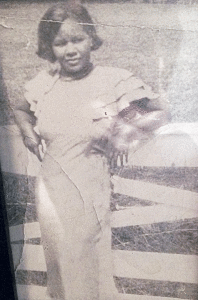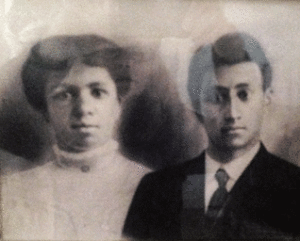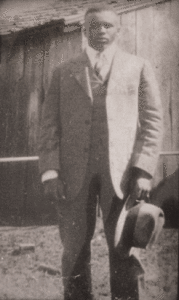
Kathleen Richardson Williams — 101 Years Old
 A Unique Life Experience
A Unique Life Experience
Michele Cuseo
Most people who live in Emmitsburg know or have heard of Mrs. Williams, as she has lived here for 101 years. I know her because I went to high school with her son, Richard, who is also a personal friend. Born in 1914, she is not just unique due to her advanced age but also because of her race. She is an African American who has lived through times of major change in America, as well as in Emmitsburg.
Born Elizabeth Kathleen Richardson, Mrs. Williams’ earliest memories involve living on Old Frederick Road with her family. Her father (William Richardson) worked at Mount St. Mary’s College as an all-around handy man doing a variety of work. Her mother (Marie Butler Richardson) had five children: Joseph, Francis, Billy, Marie, and Elizabeth Kathleen. The boys all died during the flu epidemic of 1918.
Her family always had a garden, chickens, and an occasional hog that was butchered by her Uncle Bob. She remembers that they had a natural spring and a smoke house. For holidays, her cousins would visit and they would eat together, play cards, and sing songs. She recalls that her Uncle Joe played the violin and her Uncle Charlie could sing. She also remembers visiting her grandfather Butler (her mother’s father) on a farm on Irishtown Road to see some piglets. Other than this memory of her grandfather, she does not know much about her grandparents’ history. And, having no opportunity for education at that time, her past relatives would not have been able to write any stories to pass on. Any history would have had to be passed down through verbal stories.
Starting around the late teens or early 1920s, Kathleen and her sister Marie would walk to school in Emmitsburg, attending St. Euphemia (Catholic school started in 1889, managed by the Sisters of Charity) from first through eighth grades. There was a group of other children who walked together with them through two large fields and over fences in all kinds of weather. It was quite a long way to get to school, probably about one mile or more. Once at school, the two Richardson sisters and the other African-American children were segregated from the Caucasian children into a separate room for instruction. Mrs. Williams remembers the nuns who taught them: Sister Cecelia and Sister Beata. She said that Sister Beata hated when someone used the word “ain’t.” Sister would say, “Don’t talk like those ‘Darkies’ down south!” Mrs. Williams said they did learn the basics (reading, writing, and arithmetic) from the nuns. There was no public school for blacks and they were not allowed at the public (white-only) schools. She says that her parents never had the opportunity to go to school and wanted their children to have an education. Therefore, going to school at St. Euphemia was their only opportunity for an education. However, after eighth grade, there was no high school for blacks to attend unless they went to Baltimore, Maryland. Traveling to Baltimore wasn’t logistically possible for the family.
Mrs. Williams stated that she can’t remember exactly how she met her husband, Martin Williams, who was from Gettysburg. Most likely, they met because her parents knew his parents. She said that Martin was a good man. Mr. Williams served in the army for a time and also worked at the Mount. She also remembers that blacks experienced different treatment in Pennsylvania than they did in Maryland (Martin grew up in Pennsylvania and Kathleen in Maryland). In Pennsylvania, blacks were allowed to go to the theatre (sit wherever they liked) as well as other public places. This was not allowed in the state of Maryland at that point in time (seeming to reflect the lingering struggle between North and South from past Civil War conflict).
Martin and Kathleen had seven children together: Lois, Mary, Joan, Pat, Marty, Marie, and Richard. Mr. Williams died at the young age of fifty, and it was a very difficult time for Mrs. Williams having young children to raise on her own.
Mrs. Williams did get the opportunity to buy a house in town at some point after her husband died. A man named Bernie Boyle offered to sell her the house. The house had previously been owned by Mrs. Williams’ relatives, Aunt Rose and Uncle Brown. Mrs. Williams had a good amount of money to put down on the house, but she had some trouble getting a loan from the bank to cover the rest. Mr. Boyle intervened to help by telling the bank that he would go to the Thurmont Bank if they would not cooperate. They did cooperate and Mrs. Williams was able to purchase the home where she still lives today. Mrs. Williams worked a majority of her adult life for the nuns and was known for her great cooking ability that she states she learned from her mother. Chicken pot pie was her favorite dish.
It would be an understatement to say that the Catholic Church has been a big part of Mrs. Williams’ life. She attended church at St. Anthony’s near the Grotto in earlier days, where blacks were required to stay in the back of the church. Mrs. Williams remembers some misbehaving boys who used to play in the back of the church. She also remembers when things changed at the church. She distinctly remembers a priest named Father Riley who approached her and said that she could sit wherever she wanted to and no longer had to stay in the back of the church.
In the past, when a loved one died, they had a special place for blacks to be buried that was—as Mrs. Williams described—at the bottom of the hill (in the graveyard on the way to the Grotto). When Mr. Williams died in 1960, he was the first African American to be buried at the top of the hill, alongside the previous white-only burial area.
Marie Williams, Mrs. Williams’ youngest daughter (named in honor of her grandmother and aunt), said that education was very important to their family. She stated that her mother did a great job raising her seven children. They all went to Catholic school, with some continuing on to college, and all of them working at great jobs. There are now ten wonderful grandchildren.
Mrs. Williams acknowledged that the person she admired most in her lifetime was her mother. She was a wonderful mother and wonderful person. Mrs. Williams stated that she doesn’t know why she has lived so long, but that longevity does run in her family, with many members living until almost 100 years old. These days, she enjoys crossword puzzles, watching jeopardy, and is well attended by her daughter Marie, who works as a nurse.
I thanked Mrs. Williams for sharing her memories with me and embraced her hand. She embraced back with a firm grip! As I was leaving her home, I glanced over to see that she had already started working on her crossword puzzles.
 Photo of Mrs. Williams’ mother and father, Marie Butler Richardson and William Richardson.
Photo of Mrs. Williams’ mother and father, Marie Butler Richardson and William Richardson.
 Photo of Mr. Williams as a young man.
Photo of Mr. Williams as a young man.